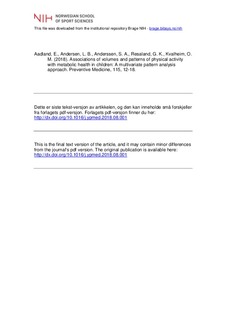| dc.contributor.author | Aadland, Eivind | |
| dc.contributor.author | Andersen, Lars Bo | |
| dc.contributor.author | Anderssen, Sigmund Alfred | |
| dc.contributor.author | Resaland, Geir Kåre | |
| dc.contributor.author | Kvalheim, Olav Martin | |
| dc.date.accessioned | 2019-08-14T09:19:18Z | |
| dc.date.available | 2019-08-14T09:19:18Z | |
| dc.date.created | 2018-09-03T14:36:48Z | |
| dc.date.issued | 2018 | |
| dc.identifier.citation | Preventive Medicine. 2018, 115, 12-18. | nb_NO |
| dc.identifier.issn | 0091-7435 | |
| dc.identifier.uri | http://hdl.handle.net/11250/2608242 | |
| dc.description | I Brage finner du siste tekst-versjon av artikkelen, og den kan inneholde ubetydelige forskjeller fra forlagets pdf-versjon. Forlagets pdf-versjon finner du på sciencedirect.com / In Brage you'll find the final text version of the article, and it may contain insignificant differences from the journal's pdf version. The definitive version is available at sciencedirect.com | nb_NO |
| dc.description.abstract | Physical activity (PA) favorably affects metabolic health in children, but it is unclear how total volumes versus patterns (bouts and breaks) of PA relate to health. By means of multivariate pattern analysis that can handle collinear variables, we determined the associations of PA volumes and patterns with children's metabolic health using different epoch settings. A sample of 841 Norwegian children (age 10.2 ± 0.3 years) provided in 2014 data on accelerometry (ActiGraph GT3X+), using epoch settings of 1, 10, and 60 s and several indices of metabolic health used to create a composite metabolic health score. We created 355 PA indices covering the whole intensity and bout duration spectrum, and used multivariate pattern analysis to analyze the data. Findings showed that bouts of PA added information about childhood health beyond total volumes of PA for all epoch settings. Yet, associations of PA patterns with metabolic health were completely dependent on the epoch settings used. Vigorous PA was strongly associated with metabolic health, while associations of light and moderate PA were weak to moderate, and associations of sedentary time with metabolic health was non-existing. Short intermittent bursts of PA were favorably associated with children's metabolic health, whereas associations of prolonged bouts were weak. This study is the first to determine the multivariate physical activity association pattern related to metabolic health in children across the whole PA intensity and bout duration spectrum. The findings challenge our understanding of PA patterns, and are of major importance for the analysis of accelerometry data. | nb_NO |
| dc.language.iso | eng | nb_NO |
| dc.subject | multivariate pattern analysis | nb_NO |
| dc.subject | metabolic risk factors | nb_NO |
| dc.subject | pediatric | nb_NO |
| dc.subject | childhood | nb_NO |
| dc.subject | pre-pubertal | nb_NO |
| dc.subject | accelerometer | nb_NO |
| dc.subject | bouts | nb_NO |
| dc.subject | breaks | nb_NO |
| dc.title | Associations of volumes and patterns of physical activity with metabolic health in children: A multivariate pattern analysis approach | nb_NO |
| dc.type | Journal article | nb_NO |
| dc.type | Peer reviewed | nb_NO |
| dc.description.version | publishedVersion | nb_NO |
| dc.source.pagenumber | 12-18 | nb_NO |
| dc.source.volume | 115 | nb_NO |
| dc.source.journal | Preventive Medicine | nb_NO |
| dc.identifier.doi | 10.1016/j.ypmed.2018.08.001 | |
| dc.identifier.cristin | 1606310 | |
| dc.description.localcode | Seksjon for idrettsmedisinske fag / Department of Sports Medicine | nb_NO |
| cristin.unitcode | 150,34,0,0 | |
| cristin.unitname | Seksjon for idrettsmedisinske fag | |
| cristin.ispublished | true | |
| cristin.fulltext | postprint | |
| cristin.fulltext | original | |
| cristin.qualitycode | 2 | |
